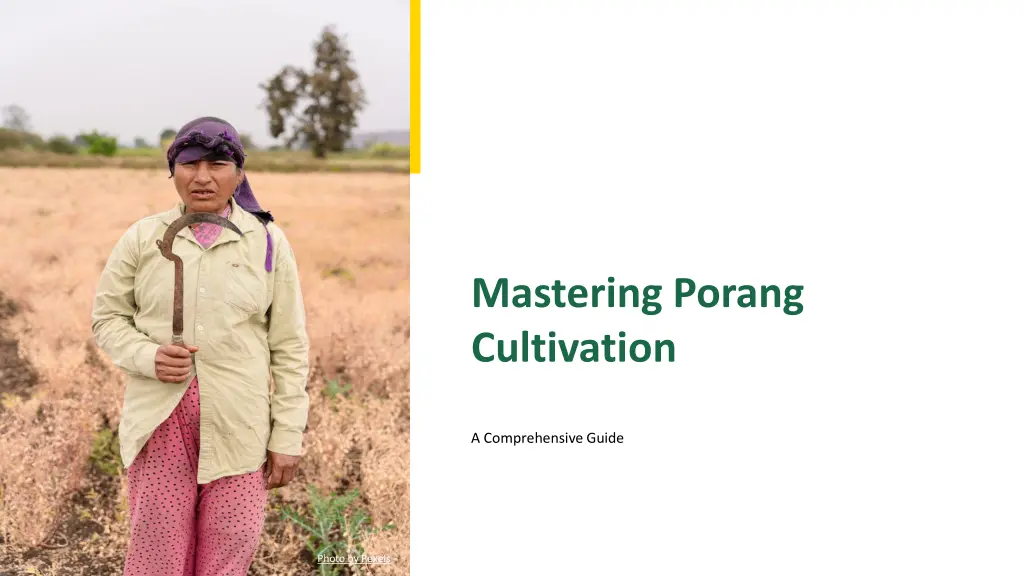
Comprehensive Guide to Porang Cultivation: Location Selection, Land Preparation, and Yield Potential
Learn the essential steps for successful Porang cultivation, including choosing the right location, preparing the land effectively, understanding yield potential, and essential production processes. Discover ideal locations in Indonesia and key factors for a thriving Porang farm. Increase productivity and income with expert insights and techniques shared in this comprehensive guide.
Download Presentation

Please find below an Image/Link to download the presentation.
The content on the website is provided AS IS for your information and personal use only. It may not be sold, licensed, or shared on other websites without obtaining consent from the author. If you encounter any issues during the download, it is possible that the publisher has removed the file from their server.
You are allowed to download the files provided on this website for personal or commercial use, subject to the condition that they are used lawfully. All files are the property of their respective owners.
The content on the website is provided AS IS for your information and personal use only. It may not be sold, licensed, or shared on other websites without obtaining consent from the author.
E N D
Presentation Transcript
Mastering Porang Cultivation A Comprehensive Guide Photo by Pexels
01 Choosing the Right Location Table of Contents 02 Ideal Locations in Indonesia 03 Preparing the Land for Cultivation 04 Understanding Yield Potential 05 Porang Production Process Overview 06 Technical Aspects of Cultivation 07 Irrigation and Water Management 08 Pest and Disease Management 09 Harvesting Techniques 10 Post-Harvest Processing 11 Conclusion and Thanks
1 Choosing the Right Location Key Selection Factors Selecting a location for Porang cultivation is critical for success, focusing on altitude and climate conditions. Areas with 100-600 meters above sea level, 1000-1500 mm rainfall, and temperatures of 25-35 C are ideal for growth. Sandy clay soils with a pH of 6-7 and proper land slopes ensure healthy cultivation and yield. Accessibility, water sources, and market proximity are vital for efficient harvest and logistics management. Photo by Pexels
2 Ideal Locations in Indonesia Top Regions to Cultivate East Java boasts Madiun, Nganjuk, and Bojonegoro as prime candidates for Porang farming. Central Java's Karanganyar and Wonogiri also provide favorable conditions for Porang cultivation. West Java, especially Cianjur and Sukabumi, offers the needed environmentfor healthy growth. Regions in Sumatra, particularly in Lampung and South Sumatra, are emerging as potentialareas too. Photo by Pexels
3 Preparing the Land for Cultivation Steps to Follow Proper land preparation is crucial; divide land into blocks of four hectares each for organized cultivation. Create paths and planting holes that facilitate access and growth, ensuring a uniform planting process. Utilize methods like mounding and maintaining a distance of 50cm between rows for optimal planting. Adjust land preparation based on slope conditions, ensuring minimal land disturbance for efficiency. Photo by Pexels
4 Understanding Yield Potential Expected Outputs Average yields for tubers are impressive, with 1 ton/ha translating to approximately 25 fruits/kg. Seed planting can yield around 350 kg/ha, producing about 172 pieces/kg, indicating profitability. Assessment of soil quality and seed type plays a major role in determining actual yield. Investing time in understanding yield potential can significantly boost productivityand income. Photo by Pexels
5 Porang Production Process Overview Key Steps Defined Start with land preparation, focusing on soil quality and depth, aiming for richness in organic content. Ideal planting conditions are crucial, requiring knowledge of rainfall and sun exposure (50-60%). Regular maintenance, including watering, organic fertilization, and pest control, ensures healthy plants. Plan for timely harvesting, which varies from tubers at 8 months to seeds at 1.5 years. Photo by Pexels
6 Technical Aspects of Cultivation A Closer Look Effective land preparation involves removing weeds and loosening soil to enhance growth conditions. Incorporating manure and adjusting soil pH are essential for creating a fertile environment. Construct beds that are wide and high enough to promote healthy drainage and nutrientretention. Understanding the nuances of the planting process allows for optimal nutrient uptake and growth. Photo by Pexels
7 Irrigation and Water Management Essential for Growth Regular watering is a core maintenance step, crucial in the early stages of Porang growth. Explore irrigation methods that ensure plants receive adequatemoisture without flooding the roots. Monitor local rainfall patterns to determine supplementary watering needs throughoutthe growing season. Water quality and availability can greatly affect the success of Porang cultivation efforts. Photo by Pexels
8 Pest and Disease Management Keeping Your Crops Healthy Pest control is vital; regularly inspect crops and remove affected parts to prevent spread. Implement organic fertilization methods to promote soil health and combat disease naturally. Stay informed about common diseases affecting Porang to address issues promptly. Educating yourself on integrated pest management strategies will protect yield potential. Photo by Pexels
9 Harvesting Techniques When and How Harvesting tubers typically occurs 8 months post-planting; seeds require up to 1.5 years. Use clean tools and proper techniques to minimize damage duringthe harvest process. Logistics planning helps ensure a smooth transition from field to market or processing facilities. A successful harvest maximizes profitability and paves the way for re-plantingefforts. Photo by Pexels
10 Post-Harvest Processing Key Steps to Follow Post-harvest care involves cleaning tubers, which is essential before any furtherprocessing. Cutting and drying tubers appropriately ensures quality and longevity for future sale or storage. Invest time in learning about effective post-harvest techniques to enhance product value. Proper processing is key to establishing a foothold in the market for Porang products. Photo by Pexels
11 Conclusion and Thanks Wrapping Up In conclusion, mastering Porang cultivation requires strategic planning, attention to detail, and continuous learning. Thank you for joining this presentation and exploring the rich opportunities in Porang farming. Let's grow together in this exciting agricultural venture and achieve sustainable success. Feel free to reach out with questions or for further discussions on this topic. Photo by Pexels
